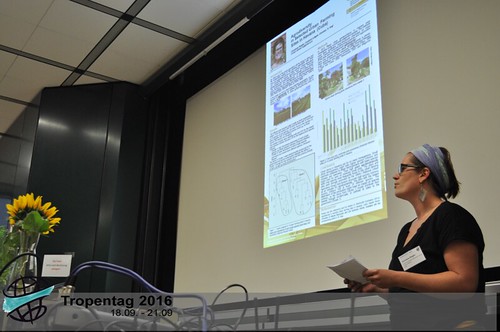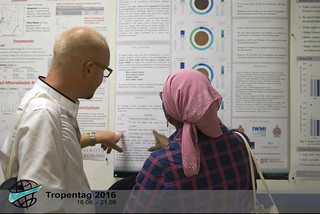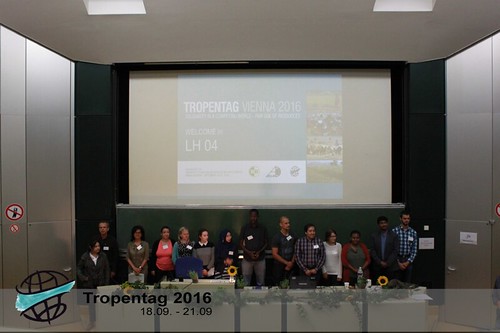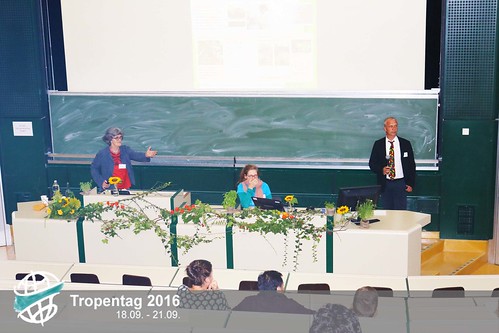Poster sessions 2016
Organic Farming Systems: from Kenya to Cuba
Tue, 09/20/2016 - 01:18 — FadliThe first session of guided posters presentation was held on Monday, 19th September. I personally got particularly interested in the organic farming systems topic. There are six intriguing poster presentations related to current studies on organic farming. The following are the overviews of the presentations:

Christiane Ringler described agrobiodiversity in 15 urban gardening plots in Havanna, Cuba. She found 130 different plant species mostly as leafy vegetables, tubers, fruits and spices from 65 different families, and concluded that small urban farms might have higher species richness and evenness compared to larger gardens.
Bernhard Freyer, head of the Division of Organic Farming at BOKU and among the main organizers of Tropentag 2016, offered a stimulating lecture on growth and productivity of clover in the highlands of the Ethiopian Awi Zone. Different levels of organic treatment applied to clover, farmyard manure, fresh sesbania manure, and a combination of the two manures. As he explained, a high amount of organic manure as fertilizer has a strong impact on clover yield.
Crop Diversity Poster Session - Amaranth for the Win
Mon, 09/19/2016 - 19:45 — ElsbyThe first round of poster presentations took place this evening, with “Crop Diversity and Plant Breeding” showcasing its inaugural topics. Many the research projects of the session, including a handful of Master’s degree theses, such as an Andean tuber crop that can be used to treat diabetes; the amaranth plant which has religious Mayan significance; and sage genetic diversity, known for its seed oil uses.
One poster which stood out to me was the “unconventional vegetable” amaranth, presented by Roland Schafleitner. This plant can be used as both a grain and vegetable product, although it is highly perishable as the latter. This plant is popular in Africa and Asia, but no breeding research is currently being undertaken. It presents an opportunity for crop breeding and innovation, as well as collaboration between project cooperators (which the presenter is actively searching for!). It is an especially good research subject for genetic diversity as it is a C4 plant (resistant to heat and drought), and can produce new generations (and seeds) relatively quickly.
Biochar and Thirsty Goats
Mon, 09/19/2016 - 19:45 — BackhausI don’t know if everyone would agree with me that poster sessions are very entertaining. The first one on Monday about soil fertility and nutrient management (1.2) was actually quite insightful (supposing one has some interest in fertilisers made from waste and fecal sludge or manure from thirsty goats, which sounds meaner than it is – or isn’t it?).
The main topic of this session was biochar: Just put biochar on maize and see what happens. Irrigate your crop with wastewater or add biochar and, again, see what happens. Filter your wastewater with biochar, put the biochar on your crop and, oh yes, see what happens.

These research topics were indeed highly interesting, and I would invite you to go see the posters yourself and get your own impression. You will also find more information about conservation agriculture practices in Kenya and how to grow Cassava in the D.R. Congo.
By the way, there will be another poster session about this subject tomorrow morning, and the oral presentations at 11:30 am. It’s certainly worth a look!
Guided Poster section 3.1
Mon, 09/19/2016 - 19:26 — PoscherIn a very short X minutes wrap up, a big diversity and good mix of presentations and topics from all over the world were presented.
7 Posters from latin America, 4 Posters from Asia and 3 from Africa were displaied. They included topics of Forest Establishment, Agroforestry, Fodder, Policies, Community Forestry, Livelihood Enhancement and Landscape Restoration.
 Even though the short time didn't allow to dive deeper into the topics, the presentations have definitely given hope to see the next generation of researchers growing up, continuing the strive to gain knowledge and foster improvement.
Even though the short time didn't allow to dive deeper into the topics, the presentations have definitely given hope to see the next generation of researchers growing up, continuing the strive to gain knowledge and foster improvement.
For an overview of the presenters with all the related poster just have a look at https://www.flickr.com/photos/tropentag/albums/72157672957864691/with/29...





